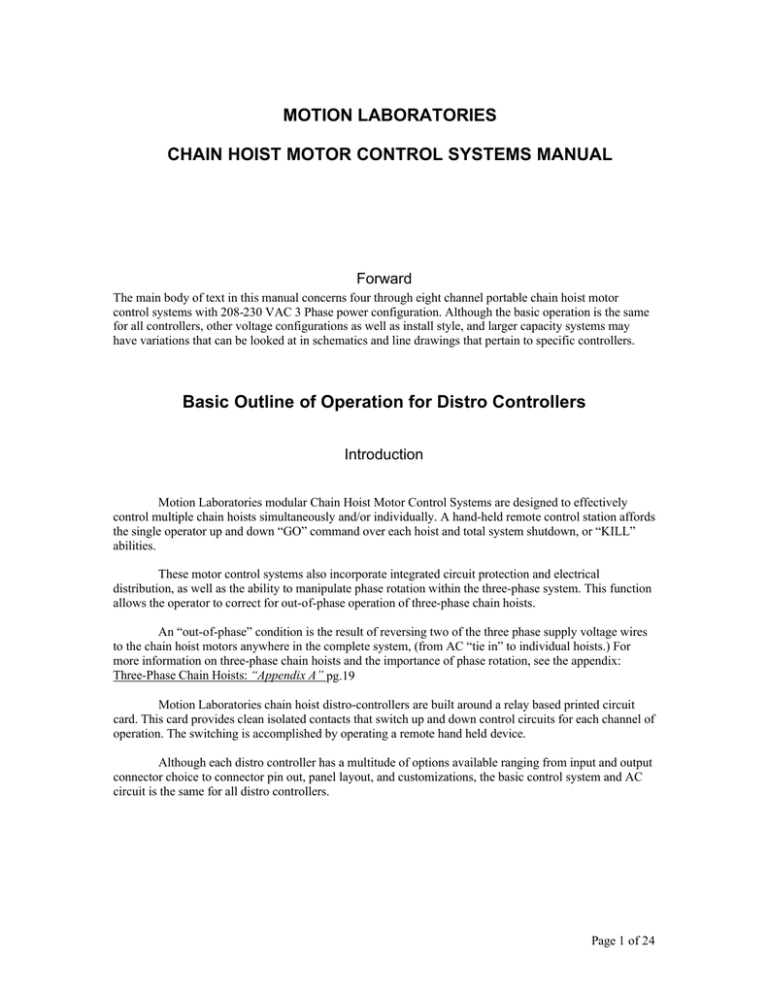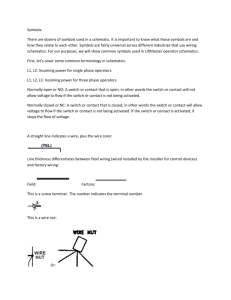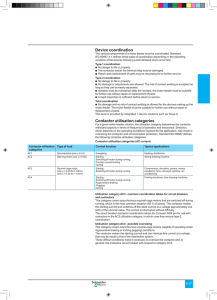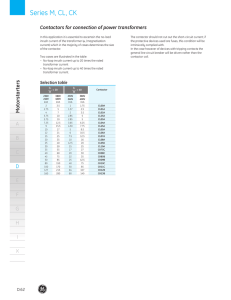MOTION LABORATORIES CHAIN HOIST MOTOR
advertisement

MOTION LABORATORIES CHAIN HOIST MOTOR CONTROL SYSTEMS MANUAL Forward The main body of text in this manual concerns four through eight channel portable chain hoist motor control systems with 208-230 VAC 3 Phase power configuration. Although the basic operation is the same for all controllers, other voltage configurations as well as install style, and larger capacity systems may have variations that can be looked at in schematics and line drawings that pertain to specific controllers. Basic Outline of Operation for Distro Controllers Introduction Motion Laboratories modular Chain Hoist Motor Control Systems are designed to effectively control multiple chain hoists simultaneously and/or individually. A hand-held remote control station affords the single operator up and down “GO” command over each hoist and total system shutdown, or “KILL” abilities. These motor control systems also incorporate integrated circuit protection and electrical distribution, as well as the ability to manipulate phase rotation within the three-phase system. This function allows the operator to correct for out-of-phase operation of three-phase chain hoists. An “out-of-phase” condition is the result of reversing two of the three phase supply voltage wires to the chain hoist motors anywhere in the complete system, (from AC “tie in” to individual hoists.) For more information on three-phase chain hoists and the importance of phase rotation, see the appendix: Three-Phase Chain Hoists: “Appendix A” pg.19 Motion Laboratories chain hoist distro-controllers are built around a relay based printed circuit card. This card provides clean isolated contacts that switch up and down control circuits for each channel of operation. The switching is accomplished by operating a remote hand held device. Although each distro controller has a multitude of options available ranging from input and output connector choice to connector pin out, panel layout, and customizations, the basic control system and AC circuit is the same for all distro controllers. Page 1 of 24 Overview of Power Wiring Power enters the distro controller through an input connector (reference dwg. 001 REVERSING CONTACTOR CIRCUIT) determined by several factors such as: 1) Available power configuration. What available power configuration do you have to run the chain hoists? 2) Power requirements of the chain hoists. What is the current draw, voltage, and quantity of hoists being used? 3) Restrictions or limitations placed on the controller by the end user. Power is then routed to the Phase Reverse Contactor Assembly. This assembly sends power to the circuit breakers or prevents power from getting there (opens or closes the circuit). These contactors also have the capability of reversing the phase rotation of the power if necessary. The phase reversal occurs between the X and the Y phases leaving the Z phase alone. The Relay Power Supply and indicator lights are fed from the line side of the contactor and are thus never interrupted by contactor operation. NOTE: For installations the phase reverse option may not be used. Power then leaves the load side of the contactor and is routed to the output circuit breakers. Power can exit the controller in a variety of formats such as: A flanged receptacle (for dual twist style), Specified pins (for multi-pin style), or Terminal blocks (for install style controllers). Page 2 of 24 Within the motor housing, (reference dwg. 002 SINGLE MOTOR CIRCUIT) power is routed thru a direction contactor assembly to the motor armature. In addition power is stepped down to control voltage by a transformer and sent back to the distro controller relay card (via a flanged inlet connector in a dual twist application or a specific pin on a multi-pin). The control signal is then routed through either the up or down relay, back to the motors’ direction contactor coils (using the same connections described earlier). Back in the motor the signal returns to the transformer via the limit switches, completing the circuit and resulting in motor movement. For further details in operation of the relay card refer to dwg. PDO1.SCH titled RELAY BOARD pg.23 STANDARD INTERNAL WIRING COLORS FOR CONTROLLERS ARE: BLACK = X PHASE RED = Y PHASE BLUE = Z PHASE GREEN = GROUND BROWN = UP SIGNAL VIOLET = COMMON (POWER FROM MOTOR) YELLOW = DOWN SIGNAL Page 3 of 24 Main 40 Module and Controls The main components of the control system are housed in a three rack space module referred to as a Main 40. This module includes the Phase Reverse Contactor Assembly, Relay Power Supply, 26 Pin Connector, Phase Reverse and Contactor Enable Switches and Power and Phase Indicators, and is available in several formats described below. 1) Main 40-1 has a single input connector PHASE OK REMOTE MODULAR POWER DISTRIBUTION AND MOTOR CONTROL SYSTEMS NEW YORK 2) Main 40-2 has an input and pass thru combination of connectors. PHASE OK REMOTE MODULAR POWER DISTRIBUTION AND MOTOR CONTROL SYSTEMS NEW YORK 3) Main 40-0 used when the input connector does not fit the above and requires an additional panel. In addition to the Main 40’s there are other panels used to house the components listed above in different locations within the controller depending upon the size and layout. PHASE OK REMOTE MODULAR POWER DISTRIBUTION AND MOTOR CONTROL SYSTEMS NEW YORK Page 4 of 24 Page 5 of 24 In order to fully understand the operating functions of these distro controllers we will explore each of the Main 40 controls referring to dwg. 003 MAIN 40 FRONT VIEW for their location. PHASE OK REMOTE MODULAR POWER DISTRIBUTION AND MOTOR CONTROL SYSTEMS NEW YORK REMOTE PHASE OK Page 6 of 24 1) Contactor Enable Switch (CE) Page 7 of 24 The Contactor Enable switch is a maintained switch. It has a yellow lens that is backlit by a replaceable 14-volt incandescent lamp. The switch lamp is paralleled off the contactor drive relay and as such will light whenever the Phase Reverse Contactor Assembly is energized When the switch is disengaged (reference dwg.004) it allows, via switch block B1a pins 1 & 2, +12VDC from the relay board panduit connector J2 pin 9 to exit the distro controller on the 26 pin connector pin V providing power to the Hand Held Remote Station. Switch block B1b pins 1 & 2 allows power from J4 to energize the contactor drive relay. Page 8 of 24 When the switch is engaged (reference dwg.005) it shuts off power to the hand held remote station via pin V and applies +12VDC from the power supply directly to the Contactor Drive Relay via switch block B1b pins 3 & 4. To summarize, with the switch disengaged the contactors are activated by the Hand Held Remote Station and with the switch engaged the contactors are energized and the Hand Held Remote Station is disabled. Page 9 of 24 2) Phase Reverse Switch (PR) Page 10 of 24 The Phase Reverse switch is a maintained switch. It has a green lens that is backlit by a replaceable 14-volt incandescent lamp. The switch lamp is wired directly to the Relay Power Supply so it will be lit whenever the distro controller is powered. When the switch is disengaged (reference dwg.006) the phases of power that are connected to the X and Y legs are routed via switch block B2 to the X and Y pins of the phase module respectively. This allows the phase ok lamp to become lit if the power is in the correct phase rotation. At the same time switch block B1 routes control power from the contactor drive relay to the C1 or in-phase contactor. Page 11 of 24 If the input power were reversed at the point of tie in the phase module would sense incorrect phase rotation and thus not light the phase ok lamp. To correct this condition in the control circuit requires the action of engaging the Phase Reverse Switch. When the switch is engaged (reference dwg.007) the X leg input is routed via switch block B2 to the Y pin of the phase module and the Y leg input is routed to the X pin of the phase module. This allows the Phase ok lamp to illuminate again. Switch block B1 then re-routes control power to the C2 or out of phase contactor. Page 12 of 24 3) 26 Pin Connector This is a ¼ turn bayonet style connector used to connect the Hand Held Remote Station to the distro controller. For pin out information refer to document “P26 Remote Station Cable Pinout” MOTION LABORATORIES P26 REMOTE STATION CABLE PINOUT PIN # COLOR FUNCTION PANDUIT POSITION A B C D E F G H J K PINK TAN RED/GREEN RED/YELLOW RED/BLACK WHITE/BLACK WHITE/RED WHITE/GREEN WHITE/YELLOW WHITE/BLUE CH 1 UP CH 1 DOWN CH 2 UP CH 2 DOWN CH 3 UP CH 3 DOWN CH 4 UP CH 4 DOWN CH 5 UP CH 5 DOWN J1 P1 J1 P2 J1 P3 J1 P4 J1 P5 J1 P6 J1 P7 J1 P8 J1 P9 J1 P10 L M N P R S T U V W YELLOW VOILET GRAY ORANGE BLUE BROWN RED BLACK WHITE GREEN CH 6 UP CH 6 DOWN CH 7 UP CH 7 DOWN CH 8 UP CH 8 DOWN KILL GO 12VDC+ GROUND J2 P1 J2 P2 J2 P3 J2 P4 J2 P5 J2 P6 J2 P7 J2 P8 J2 P9 J2 P10 X Y Z a b c WHITE/BROWN WHITE/ORANGE WHITE/GRAY WHITE/VIOLET WHITE/BLACK/RED WHITE/GLACK/GREEN RESERVED FOR FUTURE USE 4) Phase OK Lamp This is a 12-volt incandescent lamp that is replaceable as an assembly only. It will light only if the power is in the correct phase rotation for proper operation of your system motors. There are many variables that effect this process such as motor wiring, connector wiring, and cable wiring, and at times factory assistance may be required to insure proper operation. 5) Neon Power Indicators These are standard 125-volt neons wired with one side in parallel and the other side of each to a separate phase as shown below. Page 13 of 24 Hand Held Remote Station This assembly contains a face plate housing: 1) A GO switch 2) A KILL switch 3) Direction switches 4) Led indicators (Green for UP and Amber for DOWN) 5) A 10’ 26 pin cable with a ¼ turn bayonet style connector All enclosed in a high impact, ergonomic housing, injection molded of a durable yellow polyamide. Refer to dwg.008 for location of items. GO KILL 1) Direction Switches with Led indication These are spdt switch assemblies (up-off-down) that are mounted directly to a custom designed printed circuit card. During normal operation, when the switch is moved to an up or down position the triangular LED above or below will light. This will enable the channel or channels selected to operate when the GO switch is depressed. Page 14 of 24 2) Go Switch This is a momentary switch. It has a blue lens that is backlit by a 14volt replaceable incandescent lamp. Operation of this switch will provide the selected direction switches with a path to ground allowing relay closure and thus motor operation. The lamp shuts off when the GO switch is depressed. Page 15 of 24 3) Kill Switch This is a maintained switch. It has a red lens that is backlit by a 14volt replaceable incandescent lamp. Operation of this disengages the Phase Reverse Contactor Assembly interrupting power to all motors. This switch also shuts off its own lamp as well as the lamp in the go switch. The direction switches and their associated LED’s will still remain functional, even operating the relays in the distro controller if the Go Switch is engaged. NOTE: even though the relays are operating, power is interrupted to the motors preventing movement. One point to remember: if the contactor enable switch is engaged the hand held will become completely inoperable. For further details in the operation refer to the doc. titled HAND01SCH Page 16 of 24 Unit Start-Up Apply power to the distro controller. With the Hand Held Remote Station (HHRS) disconnected and all panel control switches (phase reverse and contactor enable) disengaged, the three power neons will light. The phase reverse switch will also light giving you confirmation that the Relay Power Supply is functional. In addition, if all three phases of power are present in the proper order for correct rotation, the phase ok lamp will light. Phase OK functions are determined by customer provided information and can be modified to fit different needs. The Contactor Enable switch (CE) will light whenever the contactors are engaged. Engage the CE switch and you will hear the contactors pull in, at this point providing power to the motors for local pickling. Note that at this point power to the remote connector is interrupted, preventing anyone from using a HHRS while local pickling is being done. Operating the Phase Reverse switch (PR) will result in the Phase Reverse Contactor Assembly changing contactors evidenced by an audible engagement sound. Operation of the relay card is accomplished by attaching the HHRS to the distro controller and operating the switches. Before attaching the HHRS to the distro controller, make sure that the CE switch is disengaged. NOTE: If the CE switch is engaged the HHRS will not be functional. The HHRS is attached by a military style 26 pin ¼ turn connector. As the hand held remote station is connected you will hear the contactors engage and see the GO and KILL switches on the hand HHRS light up. Selecting up and down direction switches will result in the corresponding triangular LED’s lighting. Those selected channels will operate in the chosen direction when the GO switch is depressed. The KILL switch, when depressed, will disengage the Phase Reverse Contactor Assembly in the distro controller. Note that while the Kill switch is engaged the triangular LED’s will still light while the GO and KILL switches will not. For an overview of the AC circuit refer to dwg.009 schematic and doc. Titled MAIN 40 3 PHASE WIRING (pg 21 and below) for component placement and pictorial. Page 17 of 24 GLOSSARY OF TERMS 26 PIN CONNECTOR: A bayonet style multi-pin connector used to connect the Hand Held Remote Station to the distro controller. CHAIN HOIST MOTOR CONTROL SYSTEM: A combination of components used to control multiple chain hoist motors. CONTACTOR: A set of contacts rated at more than 20 amps controlled by a coil used in motor starting applications, and to control lighting, heating, transformer, and capacitive loads. CONTACTOR ENABLE SWITCH: A maintained switch used to manually engage the Phase Reverse Contactor Assembly and interrupt power to the Hand Held Remote Station CONTACTOR DRIVE RELAY: A normally open relay used to energize the phase reverse contactor assembly. DIRECTION SWITCHES: The SPDT (single pole double throw) toggle switches mounted to the face plate of a remote hand held, responsible for up, off, and down commands to each individual motor DISTRO CONTROLLER: The portion of a chain hoist motor control system that includes the power input, overcurrent protection, power and control output connections, and other associated components. DUAL TWIST LOCK: The term referring to motor power/control connections where a twist lock connector is used for power and a second twist lock connector is used for the control circuit. GO SWITCH: A momentary switch used to activate movement on any channels selected by the direction Switches in the Hand Held Remote Station. HAND HELD REMOTE STATION: The device used to send up, down, go, and kill, commands to the distro controller. KILL SWITCH: A maintained switch used to disengage the Phase Reverse Contactor Assembly “killing” power to all motors. LED: Light emitting diode. Two types of LED's are used in Motion Laboratories controllers. Both green and amber triangular components are used in conjunction with direction switches to indicate the status of the switches (up-off-down). A small red led is mounted on the phase module used to indicate its mode of operation. LINE SIDE: The side of a current interrupting device that attaches to or is closest to the power source. LOAD SIDE: The side of a current interrupting device that attaches to or is closest to the operating device. MAINTAIN / MOMENTARY: refers to the operation of the phase reverse, contactor enable, go, and kill switches employed in all distro controllers and hand held remote stations. The maintain operation is commonly referred to as a latching type switch engaging or disengaging with each push. The momentary operation engages only as long as depressed. Disengaged is sometimes referred to as the “out position” and Engaged is sometimes referred to as the “in position”. MULTI-PIN: The term referring to a single locking style connector used to provide both power and control connections. NEON POWER INDICATORS: A gas filled lamp that glows when energized. 125-volt neons are used to indicate the presence of AC line power. Page 18 of 24 PANDUIT CONNECTOR: An IDC (insulation displacement connector) wiring device used to connect low voltage control signals to the relay card. PASS THRU: An output power connector that is paralleled with the input connector allowing the user to daisy chain distro controllers from one power source. The amperage and connector configuration must match. The ampacity of the circuit is limited to the rating of the connector. PHASE MODULE: This is a printed circuit card used to detect proper phase rotation at the input of the distro controller. PHASE OK LAMP: An incandescent 12v lamp used to indicate that power is present in the correct phase rotation. PHASE REVERSE CONTACTOR ASSEMBLY: A set of mechanically interlocked 3 pole contactors that serve 3 functions. 1) To provide power to the motors. 2) To interrupt power to the motors. 3) To reverse the phase rotation of power to the motors. PHASE REVERSE SWITCH: The switch used to determine which contactor of the Phase Reverse Contactor Assembly engages. PICKLE: A single channel control device up/down contact closure PIN OUT: Refers to the documented variations in control and power out put wiring schemes. RELAY: A set of contacts controlled by a coil used for light duty switching applications. RELAY CARD: The printed circuit board assembly mounted above the power supply that utilizes control relays to provide up/down command signals for each channel. RELAY POWER SUPPLY: The assembly consisting of a 12volt regulated power supply and relay card. WAGO CONNECTOR: A spring-loaded 12-position connector used to connect high voltage control signal to the relay card. Page 19 of 24 Appendix A Three Phase Chain Hoists Chain hoist three phase motors are induction motors. Induction motors are designed to take advantage of the characteristics of the three phase voltage that it uses for power. The first voltage is called X phase (also known as A phase or L1) and starts at 0 voltage, 0 degrees on its sine wave and peaks positively at its 90 degree mark. This process continues for 360 degrees. The second voltage is called Y phase (also known as B phase or L2) and starts its 0 voltage point 120 degrees later than X phase. The third voltage is called Z phase (also known as C phase or L3) and starts its 0 voltage point at 240 degrees after X phase. The AC motor takes advantage of this characteristic to provide a rotating magnetic field in its stator and rotor that is very strong because three separate fields rotate 120 degrees out of phase with each other. When three phase voltage is applied to the stator windings a rotating magnetic field is formed. The natural characteristic of three phase voltage will cause the magnetic field to move from coil to coil in the stator, which appears as though the field is rotating. This in turn causes the armature to spin following the phase rotation of X, Y, and Z. If you reverse two of the three phase supply voltage wires, the magnetic field will begin to rotate in the opposite direction. Page 20 of 24 ANY HOIST PHASE OK MODULAR POWER DISTRIBUTION AND MOTOR CONTROL SYSTEMS NEW YORK Page 21 of 24 Page 22 of 24 Page 23 of 24 Page 24 of 24




